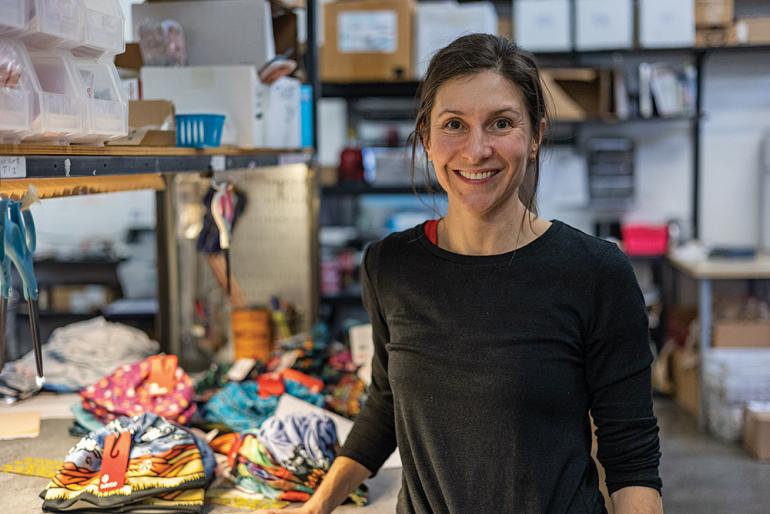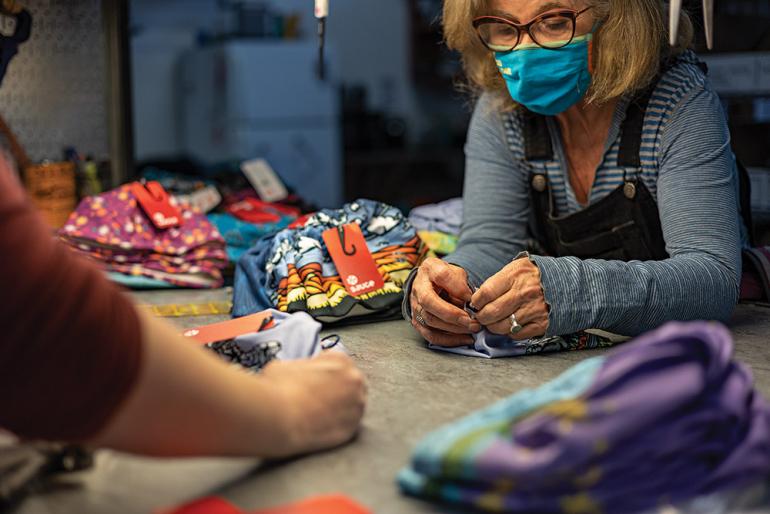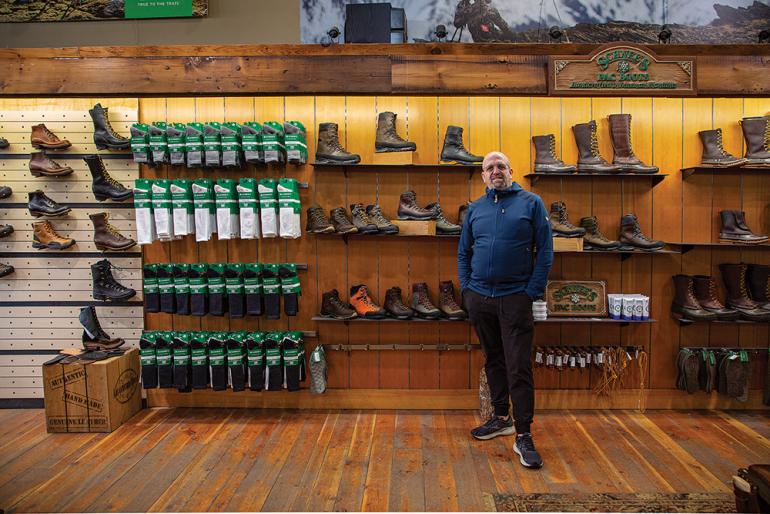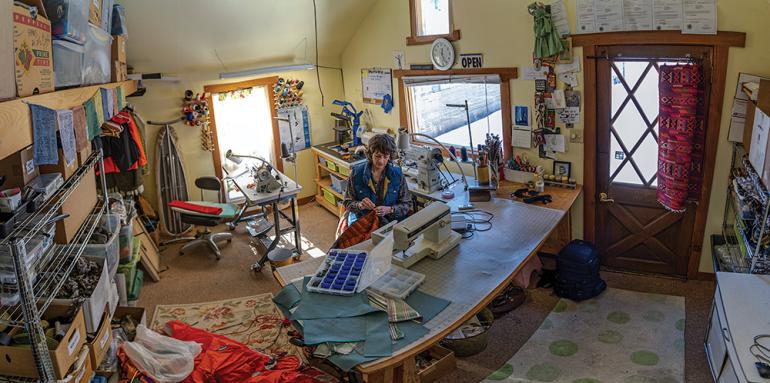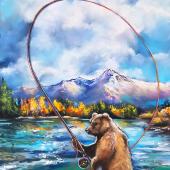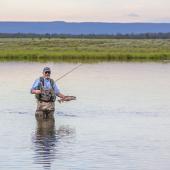From building and selling anew to maintaining the well-used, these local pros provide functional, long-lasting outdoor attire.
In southwest Montana, many of our neighbors work jobs that help us get outside and stay outside—from the beginnings of research and design, when hats and boots haven’t even seen a head or foot, through the sales process, all the way to stitching up our used gear, stretching its lifetime longer than we ever thought possible. Some of these folks have been here through thick and thin: rooted in the days of yore, adapting to the times of now. During business hours (and beyond), you can find them tucked away in their shops, carrying on in the same manner that led them to a life in the Gallatin Valley. What follows are just three of the many worth mentioning. The next time you pass one of them, indoors or out, say hi, and say thanks—they’re a big reason why the rest of us reap the benefits of Bozeman’s outdoors.
Under One Roof
The secret to making Sauce
by Jack Taylor
Tucked into a modest warehouse space off North Rouse is a workshop churning out fashionable, functional headwear for Bozeman’s active outdoor-goers. Walking in, the place is clean, but not sterile. A small team works hard, but they’re not breaking a sweat. I’m greeted by Shayla Swanson, founder and owner of Sauce. Although she’s clearly busy, she’s excited to show me around. Huge rolls of white fabric stand against the far wall. In one corner, a couple of high-quality sewing machines sit atop a large table. Two heat presses sit in the middle of the room. We sit down in the front office, next to a bright window with a large printer beneath it.
If you’ve spent any time on Bozeman’s trails or streets, you’ve seen Sauce headwear. These distinctively-patterned hats and headbands are most popular with Nordic skiers, who they were originally designed for (and by), but nowadays you’ll find them toted by any active Bozemanite when temps warrant some protection from the elements. Shayla started making hats nearly two decades ago to support her career as a Nordic racer. Born and raised in Canmore, Alberta, she moved to Bozeman in 2003 so that she could balance attending school at MSU with a high-intensity training program through the Bridger Ski Foundation.
“The first thing I ever sewed was a bean-bag frog in my home-economics class, when I was 10,” Shayla recalls. “I was a weird teenager who would stay up late, sewing clothes and making things for myself. I didn’t know what it would turn into, but this is what it looks like now!” she says, gesturing out towards the shop. Her brand started out as “SOS—Shayla On Skis,” but when she made the move to turn this side-gig into a full-on career, she realized that many other brands had the acronym “SOS” in their names. Phonetically similar and aesthetically fitting, the word “Sauce” came to mind. “It takes something bland and creates a whole new taste, adding color and variety,” Shayla writes on her website. I’d say it fits her brand to a tee.
Everyone’s part of the process from start to finish.
The designs are elegant in their simplicity: a piece of high-quality fabric, styled with a vibrant pattern, hand-sewn to make a comfortable cap or headband. For Shayla, it’s clear that her business is making waves. “I feel proud to see people out, and know that they’re choosing to put that on their head,” she says. “Of all the things they have, that’s the one they chose to wear.”
For me, it’s comforting to see the entire production process. We’re all aware that most of our clothes these days are shipped in from large factories overseas, spending weeks in transit, far detached from their original creators by the time they reach our hands. But that’s not the case with Sauce.
Shayla tells me that she used to buy pre-printed fabrics, for the sake of simplifying production. The problem was that for each different pattern, she had to buy, store, and use up an entire roll of fabric. For context, each of these fabric rolls stands about five feet tall and two feet across, yielding hundreds, perhaps thousands of headpieces per roll. Do the math: that’s tens of thousands of hats that need to be sold just to accommodate a couple dozen patterns. There had to be a better way.
So Shayla invested in a new piece of equipment: a dye-sublimation printer, letting her print any pattern in-house onto plain-white fabric. The purchase has paid off. Now, she can scale her designs to produce as many or as few hats as she wants. Whether it’s a stock run of 500 or a custom order of 20, there’s no additional purchase, storage, or waste. “We cut out all the middlemen; we’re doing it all here,” Shayla explains. And that’s when things really took off.
We're all aware that most of our clothes these days are shipped in from large factories overseas, spending weeks in transit, far detached from their original creators by the time they reach our hands. But that's not the case with Sauce.
“We send out tens of thousands of custom pieces every year,” she says. “That’s been an untapped exposure market for us.” Because of her production’s easy scalability, Shayla can offer special-made products at little extra cost for either her business or her patron. A quick perusal of the shop’s inventory shows headpieces for customers ranging from ski clubs and sports teams to local businesses and one-off events. It’s a win-win, with the consumer and designer helping to promote each other.
And at Sauce, full in-house production isn’t only a boon for Shayla herself. “Because everything is under one roof, everybody gets consulted when we’re picking patterns, or laying out custom designs,” she says. I see it firsthand: as we cruise around the shop, one of her sewing-specialists gets up to help a wholesale customer review some patterns. They’re hand-picking hats from a sampling of colorful designs to sell downtown at Girls Outdoors. “Everyone’s part of the process from start to finish,” Shayla says, “and that’s pretty rewarding.”
Everything is here; all of the materials are right in plain sight. And none of it raises an eyebrow. There are no vats of chemicals sitting around, no heavy machinery burning fossil fuels, no chimneys billowing fumes into our air, no dumpster out back brimming with waste. Nothing you’d typically associate with an apparel factory. “Producing lean,” Shayla calls it. “We’re on this really nice sustainable track.”
“We’re doing factory-type work, but we have all these little opportunities for creative outlet,” she adds. The two gals sorting through hats are discussing whether to spruce them up with some pom-poms or leave them sleek and simple. And they’re not just picking out patterns; they’re choosing from various functional designs. One piece has a ponytail hole in the back; another has a brim for sun protection. It’s clear that fashion and function don’t have to come at the cost of each other. “My interest was always in product design and function,” Shayla says, “versus just a pattern on your head. But including cool artwork on heads has been fun, too.” She points out a collection from local landscape impressionist Sarah Angst. I’m tempted to grab one and put it on.
Business is booming, and there are more hats to be made. “When I first started doing this,” Shayla reflects, “I knew everybody who might be wearing this stuff. But that’s no longer true.” It couldn’t be, when you see these hats worn in every corner of the Gallatin Valley. But she’s still engaged with customers at any chance she gets. “It’s been really fun to connect with them and learn about why they like our stuff. We get so much positive feedback, and we’re just buried in orders, which is a great problem to have.” Indeed it is—I take my leave, so Shayla can get back to work, putting hats and headbands on even more heads.
A Family Affair
Catching up with the face of Schnee's
by Eli Fournier
For Curt Smith, president of Schnee’s, it all started when he was a student at MSU. “I needed a college job, and Schnee’s looked like a good place to work,” he says. After submitting an application in the spring of 1992, Curt called back three times before finally scoring an interview with Steve and Jean Schnee. Starting out on the sales floor, Curt thrived off the structure of the job. He quickly discovered that it allowed him to become a better student, and also make the most of his free time. On his days off, he explored the Gallatin Range, backpacking and scrambling around Hyalite Lake.
As Curt grew into the job, he quickly discovered that building relationships with his customers was paramount. The epiphany came while helping customers at the fitting stool—the main tool of a boot-fitter. “I realized the more I gave to the customer,” he says, “the more I got from the customer.” Instead of bringing out one pair of shoes to try on, he would bring out five, explaining the relative advantages of each. Not only did this kind of personal attention create stronger connections, but it also propelled him up the ladder. Even now, having been president of the company for nine years, Curt still feels most comfortable at the fitting stool. “I could never do a desk job,” he says. “I have a desk, I’ve got a great office, but I don’t spend a lot of time in it because I enjoy being with the people.”
On a recent winter day, I stopped by the downtown store to explore the connection that Curt spoke of. The environment was warm and welcoming, with natural wood rafters and a soft ambiance. I chatted with his son, Tanner, who recently transitioned into the role of store manager. Tanner has the same gregarious personality as his father, who Tanner says helped shape him into the leader he is today. “It helped to listen to him and pick up on a lot of his cues,” Tanner says.”
Curt echoes the sentiment, and emphasizes that building community has always been intertwined with family. “The coolest thing that I’ve been blessed with is working with my family,” he says, referring to Tanner and his wife Shanda, who works in a human-resources role at Schnee’s. “I get to work with my wife every day, and I get to introduce my family to my customers.” Recently, however, the roles have begun to reverse, as Tanner is taking a more central role in the business. “Now, Tanner is introducing me to people,” Curt adds with a chuckle.
While developing close relationships with customers might set Curt apart in terms of building community, his store takes things one step further by hand-stitching their entire line of pac boots from start to finish at their Bozeman factory. Curt couldn’t be more proud. “People seek out things that are assembled by hand. And really, every stitch line is done one at a time.” In a market saturated with boots, Curt has helped set Schnee’s a step above the competition, and build organic relationships with local businesses and people like MeatEater’s Steven Rinella, along with Eduardo Garcia, the founder of Montana Mex.
Perhaps what has helped him more than anything to become a successful businessman, community member, and family man is the positive energy he exudes. Spend just a few minutes with him and it becomes evident that he’s passionate about his job and thrives off interacting with other people. “I don’t take many days off,” Curt says. “And I don’t sit down. I’m not much of a relaxer.” Curt ran his first half-marathon this year, and is planning to hike across the UK in April. As for what boots he will have laced up, that remains to be seen, but it’s a safe bet that they’ll be Schnee’s.
Showing Up
How the Green Darner stitched a saga
by Corey Hockett
In the early 1990s, Colleen Tretter was a ski bum in Taos, New Mexico. She worked in a fly shop for money and sewed women’s hats during her free time. But after moving to Boulder, Colorado—a place she didn’t want to be, for a guy she quickly broke up with—life took an interesting turn. With almost no money and even fewer connections, she walked into Spyder’s headquarters, pushed her way past employees to the warranty department, and found a pile of jackets with defective zippers. She told the owner she could fix them, leaving out the part that doing so would be her first time. It took some convincing, but she left with one of the jackets.
When she got home, she realized she didn’t have the right machine to mend it easily. “I gave myself 15 minutes to cry,” she says. “Then I just started taking it apart and putting it back together.” It took her 12 hours. She charged $35. Pleased with the result, the shop agreed to let her fix more. The third jacket took eight hours, but by the fifth, she’d cut her time down to five. Now she can do that same repair in an hour and ten minutes.
She made a name for herself as the woman who could repair nearly anything outdoors-related, including clothes, packs, boots, and tents.
In Bozeman circles, Colleen is known as the Green Darner, a double-entendre coupling the name of a fast-flying, needle-shaped dragonfly with her passions of sewing and sustainability. After selling that first zipper-fix, she moved to Bozeman in 2004 to take a crack at being a repair seamstress full-time. “I made up my mind that I really wanted to apply myself to this one thing,” she says. “And if I wanted people to take it seriously, then I needed to take it seriously.”
Colleen spent the next five years sewing during the day and waiting tables at night. Though she limited her marketing to a handful of posters around town, word started to spread. Pretty soon, she had more work than she knew what to do with. Before long, she had 5,000 yearly customers. “There were some years where I didn’t buy a ski pass,” she says. “There were times where I only fished a handful of times in a year. I had to say no to road-trips with friends. I had a single-mindedness and I needed to show up.”
Show up she did. Rather, used goods showed up—Colleen just fixed them. She made a name for herself as the woman who could repair nearly anything outdoors-related, including clothes, packs, boots, and tents. When Conrad Anker, Jimmy Chin, and Renan Ozturk requested a custom portaledge to take on their expedition to Meru, she helped sew it. When a marine who lost his legs in Iraq was looking for a pant to keep him dry on a hunting trip in Alaska, she sewed that, too.
Colleen sewed a few things from the ground up, but to her it was always about fixing used goods. She rued the prospect of people sending things to the landfill. That’s why she became such an invaluable resource for the community—she was the person who could keep people’s beloved gear and apparel out of the landfill and in good repair for years to come.
She still sacrifices many a ski day and fishing trip to help repair gear for friends and others in the community.
Outside of the general public, her customer base grew gradually but consistently. Big Sky Ski Patrol was one of her first recurring clients, oftentimes dropping off full garbage bags of packs around Thanksgiving to be repaired for the upcoming year. She’s worked with Trew Gear, Eddie Bauer, and Simms, among others. Three years ago, Sitka called her and offered her a near-full-time contract. She accepted, and life changed again.
On a sunny day in February, I visit Colleen at her backyard studio in north Bozeman. The space is cute, cozy, and slightly cluttered. It can’t be much larger than a 16’ x 18’ storage shed, but Tretter has five sewing machines set up. Storage bins stack high against the wall, filled with leather, webbing, buckles, and other materials. I count eight pairs of scissors on the table and see two tents on the ground. At her workstation, she has a down jacket under the needle with three more articles of clothing on deck. Above her hangs a sign that reads, “Just stitchin’… no bitchin’.”
The chaos, it seems, is part of the charm.
She fills me in on her past—this room is where she’s served customers for years—but admits that she feels a bit phony for having me over. “This Sitka thing is great,” she says. “But it’s made me less available to the public.” She explains that Bozeman’s changing culture shifted her mindset. “I’ve always enjoyed working with companies, because my goal from the get-go was to reduce waste (hence, the Green Darner) and my efforts seem to be more effective at a larger scale.” But that’s not everything. As Bozeman grew bigger, so did demand. Colleen noticed an uptick in dealing with difficult people; people that want it done perfect and want it done yesterday. That, combined with the incentive of a stable income, was enough to switch gears. After she settled on a deal with Sitka, she took down her website and even changed her phone number. I kid her about being a sellout.
“The thing about being a sellout,” she says, chuckling, “is that I didn’t know if I would be able to afford to stay in Bozeman.” But the other thing she points out is that working exclusively for a company allows her a stronger voice to encourage manufacturers to make products more sustainable—something that’s shaped her values since day one. “Still,” she says. “I feel like I’m letting people down.”
Her contract with Sitka is set to last through April. Whether she will renew or let it expire remains to be seen. Colleen currently spends around 35 hours per week in the hunting shop’s warranty department, but still devotes a great deal of time to sewing for others. She still sacrifices many a ski day and fishing trip to help repair gear for friends and others in the community. Recently, she even gave one of her sewing machines away to a stranger just because he told her that he wanted to learn to sew.
Does that sound like a sellout? Perhaps some think so, but it’s likely that there are many more who think the opposite, who feel gratitude for her “showing up” all those years, keeping their gear functional and out of the landfill, and can only hope that one day, the Green Darner comes back.



